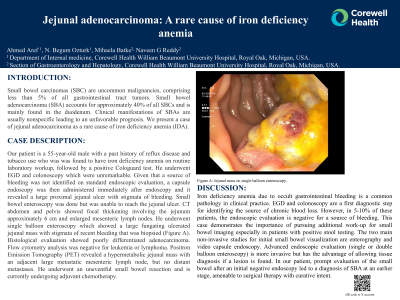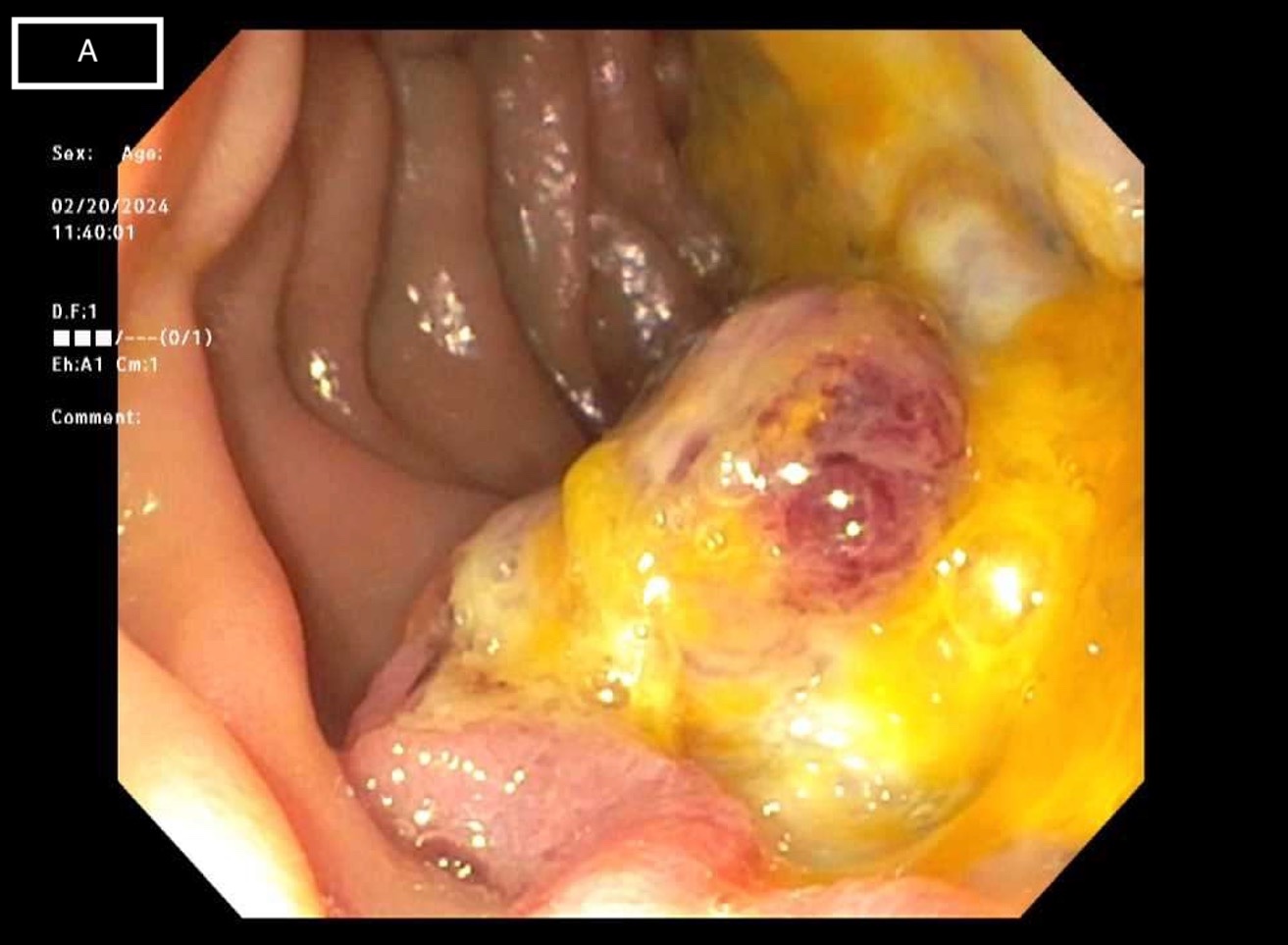Monday Poster Session
Category: Small Intestine
P3275 - Jejunal adenocarcinoma: A rare cause of iron deficiency anemia
Monday, October 28, 2024
10:30 AM - 4:00 PM ET
Location: Exhibit Hall E

Has Audio
- AA
Ahmed Aref, MBBCh
Corewell Health William Beaumont University Hospital
Royal Oak, MI
Presenting Author(s)
Ahmed Aref, MBBCh1, Nazli Begum Ozturk, MD1, Mihaela batke, MD2, Naveen Reddy, MD2
1Corewell Health William Beaumont University Hospital, Royal Oak, MI; 2Corewell Health, Royal Oak, MI
Introduction: Small bowel carcinomas (SBC) are uncommon malignancies, comprising less than 5% of all gastrointestinal tract tumors. Small bowel adenocarcinoma (SBA) accounts for approximately 40% of all SBCs and is mainly found in the duodenum. Clinical manifestations of SBAs are usually nonspecific leading to an unfavorable prognosis. We present a case of jejunal adenocarcinoma as a rare cause of iron deficiency anemia (IDA).
Case Description/Methods: Our patient is a 55-year-old male with a past history of reflux disease and tobacco use who was was found to have IDA on routine laboratory workup, followed by a positive Cologuard test. He underwent esophagogastroduodenoscopy (EGD) and colonoscopy which were unremarkable. Given that a source of bleeding was not identified on standard endoscopic evaluation, a capsule endoscopy was then administered immediately after endoscopy and it revealed a large proximal jejunal ulcer with stigmata of bleeding. Small bowel enteroscopy was done but was unable to reach the jejunal ulcer. CT abdomen and pelvis showed focal thickening involving the jejunum approximately 6 cm and enlarged mesenteric lymph nodes. He underwent single balloon enteroscopy which showed a large fungating ulcerated jejunal mass with stigmata of recent bleeding that was biopsied (Figure A). Histological evaluation showed poorly differentiated adenocarcinoma. Flow cytometry analysis was negative for leukemia or lymphoma. Positron Emission Tomography (PET) revealed a hypermetabolic jejunal mass with an adjacent large metastatic mesenteric lymph node, but no distant metastases. He underwent an uneventful small bowel resection and is currently undergoing adjuvant chemotherapy.
Discussion: Iron deficiency anemia due to occult gastrointestinal bleeding is a common pathology in clinical practice. EGD and colonoscopy are a first diagnostic step. However, in 5-10% of these patients, the endoscopic evaluation is negative for a bleeding source. This case demonstrates the importance of pursuing additional work-up for small bowel visualization especially in patients with positive stool testing. The two main non-invasive studies are enterography and video capsule endoscopy. Advanced endoscopic evaluation (single or double balloon enteroscopy) is more invasive but has the advantage of allowing tissue diagnosis if a lesion is found. In our patient, prompt evaluation of the small bowel after an initial negative endoscopy led to a diagnosis of SBA at an earlier stage, amenable to surgical therapy with curative intent.

Disclosures:
Ahmed Aref, MBBCh1, Nazli Begum Ozturk, MD1, Mihaela batke, MD2, Naveen Reddy, MD2. P3275 - Jejunal adenocarcinoma: A rare cause of iron deficiency anemia, ACG 2024 Annual Scientific Meeting Abstracts. Philadelphia, PA: American College of Gastroenterology.
1Corewell Health William Beaumont University Hospital, Royal Oak, MI; 2Corewell Health, Royal Oak, MI
Introduction: Small bowel carcinomas (SBC) are uncommon malignancies, comprising less than 5% of all gastrointestinal tract tumors. Small bowel adenocarcinoma (SBA) accounts for approximately 40% of all SBCs and is mainly found in the duodenum. Clinical manifestations of SBAs are usually nonspecific leading to an unfavorable prognosis. We present a case of jejunal adenocarcinoma as a rare cause of iron deficiency anemia (IDA).
Case Description/Methods: Our patient is a 55-year-old male with a past history of reflux disease and tobacco use who was was found to have IDA on routine laboratory workup, followed by a positive Cologuard test. He underwent esophagogastroduodenoscopy (EGD) and colonoscopy which were unremarkable. Given that a source of bleeding was not identified on standard endoscopic evaluation, a capsule endoscopy was then administered immediately after endoscopy and it revealed a large proximal jejunal ulcer with stigmata of bleeding. Small bowel enteroscopy was done but was unable to reach the jejunal ulcer. CT abdomen and pelvis showed focal thickening involving the jejunum approximately 6 cm and enlarged mesenteric lymph nodes. He underwent single balloon enteroscopy which showed a large fungating ulcerated jejunal mass with stigmata of recent bleeding that was biopsied (Figure A). Histological evaluation showed poorly differentiated adenocarcinoma. Flow cytometry analysis was negative for leukemia or lymphoma. Positron Emission Tomography (PET) revealed a hypermetabolic jejunal mass with an adjacent large metastatic mesenteric lymph node, but no distant metastases. He underwent an uneventful small bowel resection and is currently undergoing adjuvant chemotherapy.
Discussion: Iron deficiency anemia due to occult gastrointestinal bleeding is a common pathology in clinical practice. EGD and colonoscopy are a first diagnostic step. However, in 5-10% of these patients, the endoscopic evaluation is negative for a bleeding source. This case demonstrates the importance of pursuing additional work-up for small bowel visualization especially in patients with positive stool testing. The two main non-invasive studies are enterography and video capsule endoscopy. Advanced endoscopic evaluation (single or double balloon enteroscopy) is more invasive but has the advantage of allowing tissue diagnosis if a lesion is found. In our patient, prompt evaluation of the small bowel after an initial negative endoscopy led to a diagnosis of SBA at an earlier stage, amenable to surgical therapy with curative intent.

Figure: Jejunal mass on balloon enteroscopy.
Disclosures:
Ahmed Aref indicated no relevant financial relationships.
Nazli Begum Ozturk indicated no relevant financial relationships.
Mihaela batke indicated no relevant financial relationships.
Naveen Reddy indicated no relevant financial relationships.
Ahmed Aref, MBBCh1, Nazli Begum Ozturk, MD1, Mihaela batke, MD2, Naveen Reddy, MD2. P3275 - Jejunal adenocarcinoma: A rare cause of iron deficiency anemia, ACG 2024 Annual Scientific Meeting Abstracts. Philadelphia, PA: American College of Gastroenterology.
